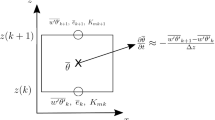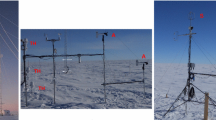Abstract
We assess sensible heat-flux parametrizations in stable conditions over snow surfaces by testing and developing stability correction functions for two alpine and two polar test sites. Five turbulence datasets are analyzed with respect to, (a) the validity of the Monin–Obukhov similarity theory, (b) the model performance of well-established stability corrections, and (c) the development of new univariate and multivariate stability corrections. Using a wide range of stability corrections reveals an overestimation of the turbulent sensible heat flux for high wind speeds and a generally poor performance of all investigated functions for large temperature differences between snow and the atmosphere above (>10 K). Applying the Monin–Obukhov bulk formulation introduces a mean absolute error in the sensible heat flux of \(6\,\hbox {W m}^{-2}\) (compared with heat fluxes calculated directly from eddy covariance). The stability corrections produce an additional error between 1 and \(5\,\hbox {W m}^{-2}\), with the smallest error for published stability corrections found for the Holtslag scheme. We confirm from previous studies that stability corrections need improvements for large temperature differences and wind speeds, where sensible heat fluxes are distinctly overestimated. Under these atmospheric conditions our newly developed stability corrections slightly improve the model performance. However, the differences between stability corrections are typically small when compared to the residual error, which stems from the Monin–Obukhov bulk formulation.





Similar content being viewed by others
References
Andreas EL (1987) A theory for the scalar roughness and the scalar transfer coefficients over snow and sea ice. Boundary-Layer Meteorol 38:159–184
Andreas EL (2002) Parameterizing scalar transfer over snow and ice: a review. J Hydrometeorol 3:417–432
Andreas EL, Persson POG, Jordan RE, Horst TW, Guest PS, Grachev AA, Fairall CW (2010) Parameterizing turbulent exchange over sea ice in winter. J Hydrometeorol 11(1):87–104. doi:10.1175/2009JHM1102.1
Arck M, Scherer D (2002) Problems in the determination of sensible heat flux over snow. Geogr Ann 84 A(3–4):157–169
Beljaars ACM, Holtslag AAM (1991) Flux parametrization over land surfaces for atmospheric models. J Appl Meteorol 30:327–341
Blanc T (1987) Accuracy of bulk-method-determined flux, stability, and sea surface roughness. J Geophys Res Atmos 92:3867–3876
Bou-Zeid E, Higgins C, Huwald H, Meneveau C, Parlange MB (2010) Field study of the dynamics and modelling of subgridscale turbulence in a stable atmospheric surface layer over a glacier. J Fluid Mech 665:480–515
Conway JP, Cullen NJ (2016) Cloud effects on surface energy and mass balance in the ablation area of Brewster Glacier, New Zealand. Cryosphere 10(1):313–328. doi:10.5194/tc-10-313-2016
Cullen NJ, Steffen K (2001) Unstable near-surface boundary layer conditions in summer on top of the Greenland ice sheet. Geophys Res Lett 28:4491–4493. doi:10.1029/2001GL013417
Cullen NJ, Steffen K, Blanken PD (2007) Nonstationarity of turbulent heat fluxes at Summit, Greenland. Boundary-Layer Meteorol 122:439–455. doi:10.1007/s10546-006-9112-2
Cullen NJ, Mölg T, Conway J, Steffen K (2014) Assessing the role of sublimation in the dry snow zone of the Greenland ice sheet in a warming world. J Geophys Res Atmos 119:6563–6577. doi:10.1002/2014JD021557
Dadic R, Mott R, Lehning M, Carenzo M, Anderson B, Mackintosh A (2013) Sensitivity of turbulent fluxes to wind speed over snow surfaces in different climatic settings. Adv Water Resour 55:178–189
Dyer AJ (1974) A review of flux-profile relationships. Boundary-Layer Meteorol 7:363–372
Essery R, Granger R, Pomeroy J (2006) Boundary-layer growth and advection of heat over snow and soil patches: modelling and parameterization. Hydrol Process 20:953–967
Essery R, Morin S, Lejeune Y, Menard CB (2013) A comparison of 1701 snow models using observations from an alpine site. Adv Water Resour 55:131–148
Föhn P (1973) Short term snow melt and ablation derived from heat- and mass-balance measurements. J Glaciol 12(65):275–289
Funk M (1985) Räumliche Verteilung der Massenbilanz auf dem Rhonegletscher und ihre Beziehung zu Klimaelementen. Zürcher Geographische Schriften. 24:183 pp
Guo X, Yang K, Zhao L, Yang W, Li S, Zhu M, Yao T, Chen Y (2011) Critical evaluation of scalar roughness length parametrizations over a melting valley glacier. Boundary-Layer Meteorol 139:307–332
Grachev AA, Fairall CW, Persson POG, Andreas EL, Guest PS (2005) Stable boundary-layer scaling regimes: the SHEBA data. Boundary-Layer Meteorol 116(2):201–235. doi:10.1007/s10546-004-2729-0
Grachev AA, Andreas EL, Fairall CW, Guest PS, Persson POG (2007) SHEBA flux-profile relationships in the stable atmospheric boundary layer. Boundary-Layer Meteorol 124(3):315–333. doi:10.1007/s10546-007-9177-6
Grachev AA, Andreas EL, Fairall CW, Guest PS, Persson POG (2013) The critical Richardson number and limits of applicability of local similarity theory in the stable boundary layer. Boundary-Layer Meteorol 147(1):51–82. doi:10.1007/s10546-012-9771-0
Högström U (1988) Non-dimensional wind and temperature profiles in the atmospheric surface layer: a re-evaluation. Boundary-Layer Meteorol 42:55–78
Holtslag AAM, De Bruin HAR (1988) Applied modeling of the nighttime surface energy balance over land. J Appl Meteorol 27(6):689–704
Huwald H, Higgins CW, Boldi MO, Bou-Zeid E, Lehning M, Parlange MB (2009) Albedo effect on radiative errors in air temperature measurements. Water Resour Res 45:W08431. doi:10.1029/2008WR007600
Joffre SM (1982) Momentum and heat transfers in the surface layer over a frozen sea. Boundary-Layer Meteorol 24:211–229
Large WG, Pond S (1982) Sensible and latent heat flux measurements over the ocean. J Phys Oceanogr 11:324–336
Lehning M, Bartelt P, Brown B, Fierz C (2002) A physical SNOWPACK model for the Swiss avalanche warning: Part III: meteorological forcing, thin layer formation and evaluation. Cold Reg Sci Technol 35(3):169–184
Marks D, Dozier J (1992) Climate and energy exchange at the snow surface in the Alpine region of the Sierra Nevada. 2. Snow cover energy balance. Water Resour Res 28(11):3043–3054
Martin E, Lejeune Y (1998) Turbulent fluxes above the snow surface. Ann Glaciol 26:179–183
Massmann WJ, Lee X (2002) Eddy covariance flux corrections and uncertainties in long-term studies of carbon and energy exchanges. Agric Forest Meteorol 113:121–144
Michlmayr G, Lehning M, Koboltschnig G, Holzmann H, Zappa M, Mott R, Schöner W (2008) Application of the Alpine 3D model for glacier mass balance and glacier runoff studies at Goldbergkees, Austria. Hydrol Process 22(19):3941–3949
Mott R, Egli L, Grünewald T, Dawes N, Manes C, Bavay M, Lehning M (2011) Micrometeorological processes driving snow ablation in an Alpine catchment. The Cryosphere 5:1083–1098
Mott R, Gromke C, Grünewald T, Lehning M (2013) Relative importance of advective heat transport and boundary layer decoupling in the melt dynamics of a patchy snow cover. Adv Water Resources 55:88–97
Mott R, Daniels M, Lehning M (2015) Atmospheric flow development and associated changes in turbulent sensible heat flux over a patchy mountain snow cover. J Hydrometeorol 16:1315–1340
Munro DS (1980) Exponential-linear stability correction functions for weak to moderate instability near the ground. Boundary-Layer Meteorol 19:125–131
Nishimura K, Nemoto M (2005) Blowing snow at Mizuho station, Antarctica. Phil Trans R Soc A 363:1647–1662
Obukhov AM (1946) Turbulence in an atmosphere with a non-uniform temperature. Trudy Inst Teoret Geophys Akad Nauk SSSR. 1:95-115 (translation in: Boundary-Layer Meteorol 1971. 2:7-29)
Plüss C, Mazzoni R (1994) The role of turbulent heat fluxes in the energy balance of high alpine snow cover. Nordic Hydrol 25:25–38
Pohl S, Marsh P, Liston GE (2006) Spatial-temporal variability in turbulent fluxes during spring snowmelt. Arct Antarct Alp Res 38:136–146
Rannik Ü, Vesala T (1999) Autoregressive filtering versus linear detrending in estimation of fluxes by the eddy covariance method. Boundary-Layer Meteorol 91:259–280
Sharan M, Kumar P (2011) Estimation of upper bounds for the applicability of non-linear similarity functions for non-dimensional wind and temperature profiles in the surface layer in very stable conditions. Proc R Soc A 467(2126):473–494. doi:10.1098/rspa.2010.0220
Smeets CJPP, van den Broeke MR (2008b) The parameterization of scalar transfer over rough ice. Boundary-Layer Meteorol 128(3):339–355. doi:10.1007/s10546-008-9292-z
Sorbjan Z (2010) Gradient-based scales and similarity laws in the stable boundary layer. QJR Meteorol Soc 136(650A):1243–1254. doi:10.1002/qj.638
Sorbjan Z (2016) Similarity scaling systems for stably stratified turbulent flows. QJR Meteorol Soc 142(695B):805–810. doi:10.1002/qj.2682
Stearns CR, Weidner GA (1993) Sensible and Latent heat flux estimates in Antarctica. Antarctic Research Series 61:109–138
Stössel F, Guala M, Fierz C, Manes C, Lehning M (2010) Micrometeorological and morphological observations of surface hoar dynamics on a mountain snow cover. Water Resources Res 46(4):W04511
Stull RB (1988) An introduction to boundary layer meteorology. Kluwer Acad Publishers, Dordrecht 666 pp
Vickers D, Mahrt L, Andreas EL (2015) Formulation of the sea surface friction velocity in terms of the mean wind and bulk stability. J Appl Meteor Climatol 54(3):691–703
Webb EK (1970) Profile relationships the log-linear range and extension to strong stability. QJR Meteorol Soc 96:67–90
Zeng X, Zhao M, Dickinson RE (1998) Intercomparison of bulk aerodynamic algorithms for the computation of sea surface fluxes using TOGA COARE and TAO data. J Clim 11:2628–2644
Acknowledgements
The work was funded by Swiss National Science Foundation (Project: Snow-atmosphere interactions driving snow accumulation and ablation in an Alpine catchment: The Dischma Experiment; SNF-Grant: 200021_150146).
Author information
Authors and Affiliations
Corresponding author
Rights and permissions
About this article
Cite this article
Schlögl, S., Lehning, M., Nishimura, K. et al. How do Stability Corrections Perform in the Stable Boundary Layer Over Snow?. Boundary-Layer Meteorol 165, 161–180 (2017). https://doi.org/10.1007/s10546-017-0262-1
Received:
Accepted:
Published:
Issue Date:
DOI: https://doi.org/10.1007/s10546-017-0262-1




